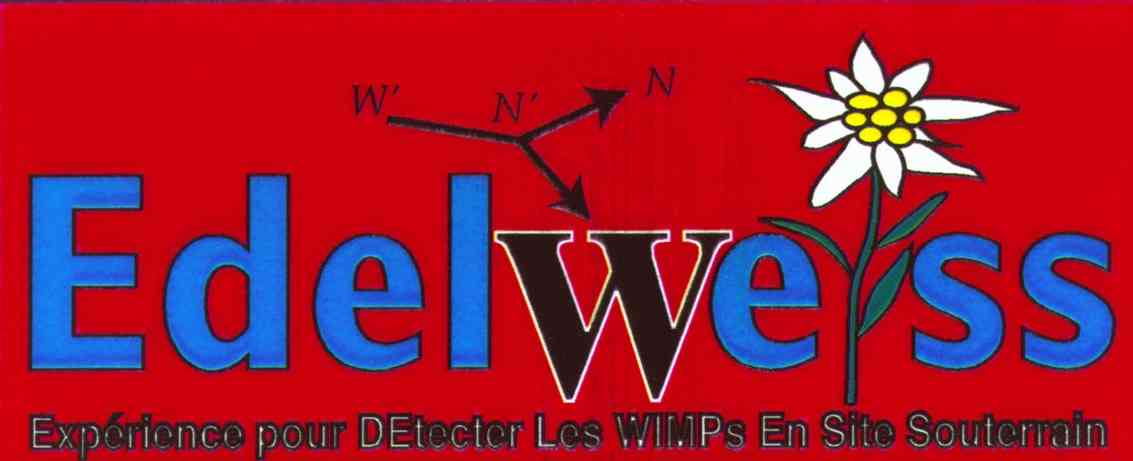Edelweiss-I and II: science goal
Astrophysical context
The identification of the nature of Dark Matter is one of the major questions of contemporary physics. A coherent set of astrophysical observations (cosmic microwave background anisotropy measurements, high-redshift supernovae luminosity studies, galaxy clusters observations,...) shows that matter contributes only for one third to the density budget of the universe (Omega_M ~ 0.3). Protons and neutrons, which are the constituents of the atomic nuclei (the baryonic matter which can emit or absorb radiation), represent only a small fraction of this matter component (Omega_B ~ 0.04). Most part of the matter filling the universe is thus invisible, non baryonic and of unknown nature! In our Galaxy, in the Sun vicinity, this Dark matter density is about 0.3 GeV/cm3 and a possible baryonic contribution from massive and compact halo objects(EROS experiment) has been found negligible.A new type of elementary particle, massive and weakly interacting, generically
called WIMP, could constitute this non baryonic Dark Matter. Thermal relics
from the Big Bang era during which they were created, and now trapped in
the gravitational field of the galaxies, these WIMPs have naturally a density
of the order of Omega_M.
Supersymmetric theories(SUSY),
allowing the unification of the four fundamental interactions, just predict
the existence of new massive particles weakly interacting with matter.
The lightest of these particles, the neutralino, which could be stable,
is one of the most motivated WIMP candidate.
The direct detection of WIMPs on Earth is possible : weakly interacting with baryonic matter by elastic scattering off target nuclei of a suitable detector, a part of the WIMP kinetic energy is released to the detector as nuclear recoil energy. But the WIMP interaction rate, constrained both by cosmological data and accelerator experiments, is expected to be extremely small: for one kilogram of detector, the rate is at most one interaction per day, and most probably much less, making the WIMPs even more elusive than neutrinos. The EDELWEISS collaboration (Expérience pour DEtecter Les Wimps En SIte Souterrain) is focused on searching the WIMPs by this direct detection scheme.
Principles of direct detection
Any direct detection experiment of WIMPs is faced with two main difficulties. First, the nuclear recoil energy induced by a WIMP interaction is very
small, of the order of a few keV to a few tens of keV, depending on the
respective neutralino and nucleus masses. The energy threshold of the detector
has to be very low. The EDELWEISS collaboration uses cryogenic detectors
at very low temperatures (about 20 mK), each made of a massive (320 g)
monocrystal of high purity germanium. The recoil energy of a Ge nucleus
is converted into heat
( measured by a temperature rise whith a precision better than one
millionth of a degree) and also into ionisation (ionisation signals of
a few hundred electrons are detectable). The energy threshold is thus as
low as 10 keV.
An other severe constraint arises from the low rate of interactions
(a fraction of one event per kg of Ge and per day) and the absence of evident
identification of the WIMP signal which may be faked by numerous background
sources (cosmic ray background, natural radioactivity of the environment
and of the experimental device itself). Our experiment is located in the
Laboratoire Souterrain de Modane (LSM)
, where the rock
coverage of 1600 m offered by the Fréjus mountain reduces the cosmic background
by more than 6 orders of magnitude (1/2 000 000) compared to the Earth surface intensity.
Yet, this is not enough, the detector has to be protected against the
natural radioactivity. Various passive protections aim at reducing this
background. From outside towards the heart of the experiment:
- a 30cm thick paraffin shield which moderates the fast neutrons (the
nuclear recoil induced reactions can mimic WIMP diffusion).
- a 15cm thick lead shield which reduces the gamma flux originating
from the lab walls by more than a factor of 1000.
- a 10cm thick copper shield which stops the low energy emissions of
the lead (due to the radioactive isotope 210Pb, of 22 years half-life).
- in the near vicinity of the detectors, an ultimate shield of ancient
lead (Roman wreck of Ploumanac'h, IVth century), the radioactivity of which,
due to 210Pb, is now completely negligible.
Very severe criteria are of course applied before validating materiels used in the experiment. Highly purified crystals of Ge have been produced for the detector itself. Any matter component in the vicinity of the detector (like electronic components, glue, solder, metals of holders,...) must show a low level of natural or cosmic induced radioactivity and have to be selected using a dedicated low-background germanium gamma-ray detector, settled in LSM.
Still, the remaining background imposes the lowest limit of the measurable rate of WIMP interactions and thus the sensitivity of the experiment. In EDELWEISS, in addition of these passive protections, a discriminatory analysis is applied using the simultaneous measurement of heat and ionisation signals. This allows the rejection, by the detector itself, of more than 99.9% of the residual gamma background (cf Detector section).
 Edelweiss-III
Edelweiss-III